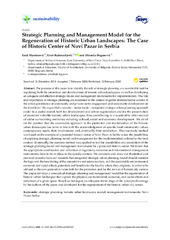Приказ основних података о документу
Strategic Planning and Management Model for the Regeneration of Historic Urban Landscapes: The Case of Historic Center of Novi Pazar in Serbia
| dc.creator | Muminović, Esad | |
| dc.creator | Radosavljević, Uroš | |
| dc.creator | Beganović, Džemila | |
| dc.date.accessioned | 2020-04-18T13:28:24Z | |
| dc.date.available | 2020-04-18T13:28:24Z | |
| dc.date.issued | 2020 | |
| dc.identifier.issn | 2071-1050 | |
| dc.identifier.uri | https://raf.arh.bg.ac.rs/handle/123456789/603 | |
| dc.description.abstract | The purpose of this paper is to identify the role of strategic planning as a sustainable tool for regulating both the protection and development of historic urban landscapes, as well as developing an adequate and effective strategic model and management instruments for implementation. The role and importance of strategic planning are examined in the context of global transformative actions in the urban governance of community and private sector engagement and sustainable development on the local level. We argue that a specific—tailor-made—integrated strategic urban planning approach could be a useful model, both for development and urban regeneration and for the preservation of protected valuable historic urban landscapes, thus contributing to a sustainable urban revival of wider surrounding territories including cultural, social and economic development. We stand on the position that the sustainable approach to the protection and revitalization of the historic urban landscapes has to be in line with the acknowledgment of specific local community values, contemporary needs, their involvement, and, eventually, their satisfaction. The case study method was based on the example of a protected historic center of Novi Pazar in Serbia to test the possibilities of applying strategic planning model and management for the implementation tailored to the local context. Eventually, the scenario method was applied to test the possibilities of a simulation of the strategic planning model and management instruments for a protected historic center. We found that the appropriate combination and utilization of regulatory, economic and informational management instruments have to be in place in the specific context. We conclude and draw out theoretical and practical remarks from our research that integrated strategic urban planning model should consider the logic and the functioning of the competitive real estate markets, and the sustainable environmental, economic and social effects, potentials and benefits for the locality where they originate, in order to be utilized as the new generative value both for the protection and for the revival of historic city centers. The paper develops a conceptual strategic planning and management model for the regeneration of historic urban landscapes that capture the physical, environmental, economic, and social effects and indicators of a given space. Based on this input, an adequate initial stage of the conceptual strategy by the authors of the paper was developed for the regeneration of the historic urban city center. | en |
| dc.language.iso | en | sr |
| dc.publisher | Basel: MDPI | sr |
| dc.relation | info:eu-repo/grantAgreement/MESTD/Technological Development (TD or TR)/36035/RS// | sr |
| dc.rights | openAccess | sr |
| dc.rights.uri | https://creativecommons.org/licenses/by/4.0/ | |
| dc.source | Sustainability | sr |
| dc.subject | strategic planning | sr |
| dc.subject | historic urban landscape | sr |
| dc.subject | model | sr |
| dc.subject | management instruments | sr |
| dc.subject | Novi Pazar | sr |
| dc.subject | Serbia | sr |
| dc.title | Strategic Planning and Management Model for the Regeneration of Historic Urban Landscapes: The Case of Historic Center of Novi Pazar in Serbia | en |
| dc.type | article | sr |
| dc.rights.license | BY | sr |
| dcterms.abstract | Муминовић, Есад; Бегановић, Джемила; Радосављевић, Урош; | |
| dc.rights.holder | MDPI | sr |
| dc.citation.volume | 12 | |
| dc.citation.issue | 4 | |
| dc.citation.spage | 1323 | |
| dc.citation.rank | M22~ | |
| dc.identifier.wos | 000522460200041 | |
| dc.identifier.doi | 10.3390/su12041323 | |
| dc.identifier.scopus | 2-s2.0-85081233956 | |
| dc.identifier.fulltext | https://raf.arh.bg.ac.rs/bitstream/id/1600/sustainability-12-01323-v2.pdf | |
| dc.type.version | publishedVersion | sr |

